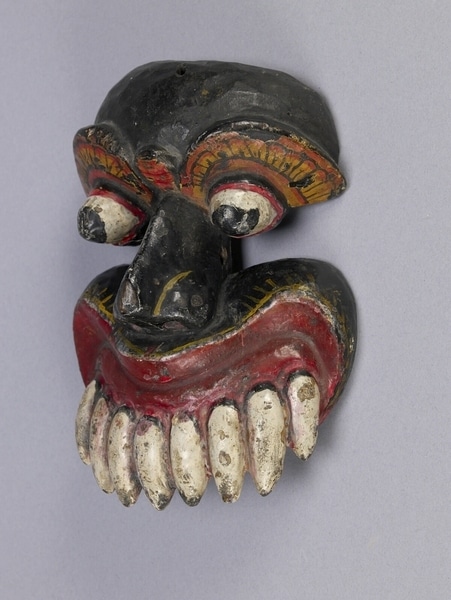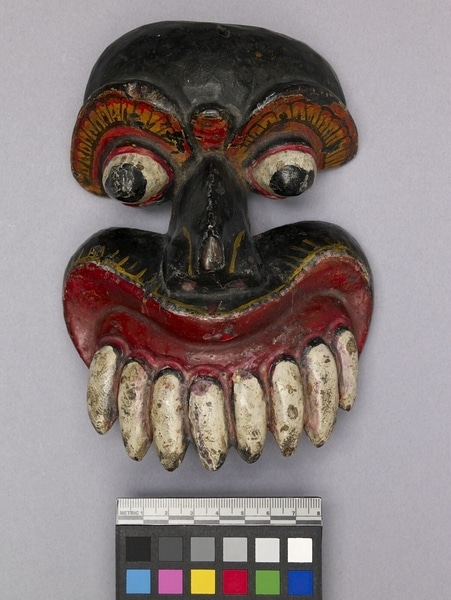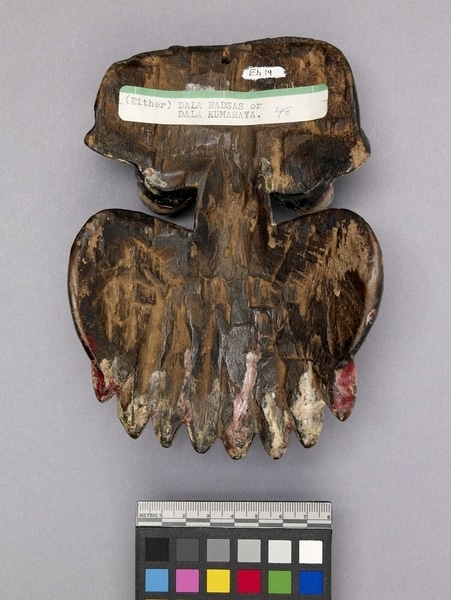Mask Item Number: Eh19 from the MOA: University of British Columbia




Description
Mask representing either Dala Radsas or Dala Kumaraya with a painted black face composed of the forehead and eyes joined to the upper lip and top teeth by the nose (there are no cheeks, ears or bottom jaw). The eyes are cone-shaped with rounded tips, the eyebrows are painted in red yellow and black with a petal motif, there is a red ovoid shape between the eyebrows, the nose is narrow with large nostrils defined by a yellow line in the crease, and the wide red upper lip is pulled back in a grimace to expose the red gums and elongated white teeth. The upper lip is decorated with a linear design in yellow. There is a hole on either side of the nose. A label on the reverse reads, "(Either) DALA RADSAS or DALA KUMARAYA," in typewritten characters, and "48" handwritten in blue ink.
History Of Use
Worn during curing ritual of the Sanni Yakuma ceremony, part of the Tovil series of dramas performed by Sinhalese ritual specialists and dancers. The Sanni Yakuma is intended to combat diseases and afflictions caused by the Sanni group of demons. These consist of 18 or more apparitions of the chief demon, Maha-kola-sanni. The officiating healer honours Buddha, then appeases the demons with offerings, dancing, and chanting. Known at birth as Dala Kumara, and possessing supernatural powers this character was abandoned by his sister with whom he was in love. He then transformed into the demon Dala Raksa. Legend suggests that the demon was brought from India by followers of the god, Kataragama, to clean festival sheds before the wedding of Kataragama and Vall Amma.
Iconographic Meaning
Black face symbolizes a demon, called Dala Raksa.
Cultural Context
exorcism
Item History
- Made in Sri Lanka before 1978
- Collected during 1978
- Owned by Jason Schoonover before February 10, 1981
- Received from Museum of Anthropology Shop Volunteers (Funding source) and Jason Schoonover (Seller) on February 10, 1981
What
Who
- Culture
- Sinhalese
- Previous Owner
- Jason Schoonover
- Received from
- Museum of Anthropology Shop Volunteers (Funding source) and Jason Schoonover (Seller)
Where
- Holding Institution
- MOA: University of British Columbia
- Made in
- Sri Lanka
When
- Creation Date
- before 1978
- Collection Date
- during 1978
- Ownership Date
- before February 10, 1981
- Acquisition Date
- on February 10, 1981
Other
- Condition
- fair
- Current Location
- Case 107
- Accession Number
- 0704/0018